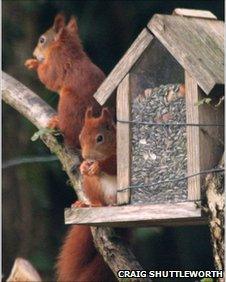Row over Newborough, Anglesey, red squirrel forest felling plans
- Published
Campaigners say the plans in Newborough forest highlight the Welsh government's "broken promises" on the site
Plans to remove trees from a forest which is home to red squirrels are causing concern on Anglesey.
Campaigners say the plans in Newborough forest highlight the Welsh government's "broken promises" on the site.
They claim ministers have reneged on pledges for a scientific consensus on any changes to the woodland where there are also important dunes.
The Welsh government said a science review was ongoing.
Red squirrels were reintroduced at the site in 1998, and the management plan has been discussed over the past 10 years.
As well as the squirrels, the plan includes the long-term management of dune habitats and species, and the changing shoreline under climate change scenarios.
'Misleading'
Environment body Natural Resources Wales said its plans involved only small areas of trees, many of which were dead or dying.
But campaigners disagree and have called a public meeting in Newborough on Thursday evening to consider reporting the Welsh government for allegedly failing to meet its commitments.
Residents claim the Welsh government is preparing to ignore EU conservation rules by allowing Natural Resources Wales' proposals to fell trees before a promised independent scientific review was completed.
The Welsh government said the claims were "misleading".
A number of trees have already been marked, prompting opponents to claim parts of the 700-hectare (1,700 acre) woodland would be felled.
Emlyn Parry-Williams, who has a smallholding on the edge of the forest, said the dispute went back to 2004 when plans were put forward to cut more than a third of the trees.
He said: "Natural Resources Wales seems to believe the process is settled, thereby ending its responsibility to the public generally and the local residents in particular. It is not the end but just the beginning.
"Much has to be publicly understood, discussed and agreed upon."
Anglesey is one of only three areas in Wales with red squirrels.
Independent research scientist Dr Craig Shuttleworth, who has worked on red squirrel projects across the UK, estimated 550 hectares (1,400 acres) of the forest were mature enough to hold a red squirrel population of 150-200 animals.
But the effects of the proposed tree loss could not be known because people had been "playing politics with the forest on a number of levels," he said.

Red squirrels have crossed from Anglesey to the mainland
Dr Shuttleworth added: "What we need is the scientific review to be completed.
"This uncertainty should not be there. I have been chasing the Welsh government on this for three years.
"I would not have bothered if I had known they were going to change the rules of the process, to become both the jury and the judge."
In a statement, Natural Resources Wales, said: "We, and our predecessor organisations, have consulted extensively with local people and specialists on our proposals since 2004, making many changes to our plans as a result.
"If the Welsh government's review concludes that the scientific basis for the proposals to manage the area are sound, than we will proceed with plans to remove some small areas of trees - many of which are dead or dying.
'No decision'
"It's completely wrong to say that large parts of the forest will be felled - this is simply not the case."
A Welsh government spokesperson said: "No decision has yet been made.
"We plan to publish more information on the review very shortly and ahead of a planned meeting with the Newborough Forest Liaison Partnership on the 11 September.
"It is worth noting that the area under consideration is a very small percentage of the 700-hectare site and that the majority of the trees in the affected areas are either dead or in poor health."
- Published30 September 2012
- Published13 July 2012
- Published3 January 2012
- Published20 December 2010